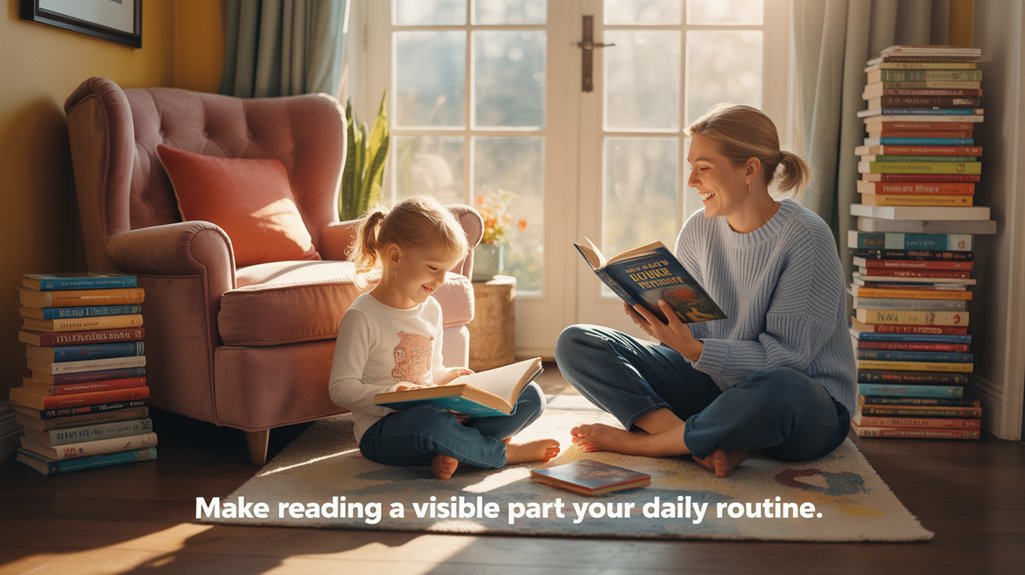Build a lasting family reading culture by first evaluating your current reality—mapping actual available time and documenting what everyone genuinely enjoys reading. Create accessible reading spaces in high-traffic areas, stock them with 20+ diverse books at various levels, and establish fixed daily reading times that work for your schedule. Model reading for pleasure yourself, turn stories into conversations rather than tests, and connect book themes to real-world experiences. Adapt your approach as children's interests evolve, and you'll discover sustainable practices that change your household into a literacy-rich environment.
Key Takeaways
- Build a diverse home library with 20+ books spanning multiple genres and rotate regularly to match family interests and developmental stages.
- Establish fixed daily reading times in cozy, accessible spaces where the entire family reads simultaneously to create predictable rituals.
- Model reading behavior by letting children observe adults reading for pleasure during designated family reading hours and casual moments.
- Prioritize open-ended conversations about stories over comprehension testing to foster genuine engagement and critical thinking skills.
- Connect books to real-world experiences through themed activities, location visits, and discussions that relate narratives to family life.
Start Where Your Family Actually Is, Not Where You Think They Should Be

Before purchasing another stack of award-winning chapter books your kids ignore, assess your family's current reading reality through three concrete metrics: actual time available for reading, existing attention spans, and genuine interest levels.
Document what everyone currently reads—including graphic novels, magazines, and online articles. Research shows that honoring reading preferences builds momentum rather than resistance.
Map your family's weekly schedule to identify realistic reading windows. A family with three evening activities won't sustain a thirty-minute bedtime reading routine. Start with five minutes instead.
Survey family interests through conversation, not assumption. Your sports-obsessed son might resist fiction but devour athlete biographies. Your art-loving daughter may prefer illustrated poetry over chapter books.
Create a simple assessment chart tracking these three areas. This baseline reveals gaps between your aspirations and reality, enabling you to build sustainable habits that serve your family's actual needs rather than idealized expectations. Remember that parents who maintain their own self-care practices, including personal reading time, model healthy behaviors that children naturally adopt over time.
Create Reading Spaces That Invite Rather Than Intimidate
Where does reading actually happen in your home—a formal library nobody enters, or the couch where everyone congregates? Your family needs reading spaces where they naturally spend time, not perfected areas that discourage casual browsing.
Transform existing gathering spots into cozy corners with simple additions. Research shows accessibility trumps aesthetics when building sustainable reading habits.
| Location | Essential Elements | Budget-Friendly Additions |
|---|---|---|
| Living room | Adequate lighting, comfortable seating | Basket of books, throw blankets |
| Bedrooms | Bedside lamp, small bookshelf | Reading pillow, book stand |
| Kitchen | Counter space for cookbooks | Recipe card holder, magazine rack |
| Bathroom | Shelf or basket | Waterproof book holder, short reads |
Focus on inviting decor that reflects your family's interests rather than catalog-perfect arrangements. Stock spaces with diverse materials at various reading levels. Remember: spaces that intimidate get avoided, while accessible corners that welcome imperfection become authentic reading havens your family will actually use.
Consider connecting with book clubs that offer age-appropriate selections for different grade levels, ensuring your reading spaces stay stocked with engaging content that matches each family member's interests and abilities.
Make Reading a Visible Part of Your Daily Routine

Children adopt habits they observe consistently, making your reading behavior a powerful model for literacy development.
Establishing fixed reading times—such as twenty minutes after dinner or before bedtime—transforms reading from an occasional activity into a predictable family ritual.
Position books in high-traffic areas like kitchen counters, living room coffee tables, and bathroom baskets so family members encounter reading materials throughout their day, increasing the likelihood of spontaneous engagement.
Designate Daily Reading Times
When families establish specific times for reading each day, children develop consistent literacy habits that persist into adulthood. Research from the National Literacy Trust demonstrates that consistent routines greatly impact reading motivation and achievement.
You'll find success by anchoring reading to existing family schedules—before bedtime, during breakfast, or immediately after school.
Consider implementing a 20-minute daily reading block when all family members read simultaneously. This creates accountability and models lifelong learning.
For households with varying schedules, designate flexible windows rather than rigid times. Track your consistency using a simple calendar or chart, celebrating weekly milestones together.
The American Academy of Pediatrics recommends daily reading sessions beginning in infancy, emphasizing that regularity matters more than duration.
Start small, remain consistent, and gradually extend your family's reading commitment.
Create Accessible Book Displays
How you arrange books throughout your home directly influences reading frequency and engagement. Research from the National Literacy Trust shows children in homes with visible book displays read 40% more often than those where books remain hidden on shelves.
Implement strategic book organization by placing age-appropriate titles in high-traffic areas—kitchen counters, coffee tables, and bathroom baskets. Rotate selections weekly to maintain interest and discovery.
Exercise display creativity through basket collections, wall-mounted ledges, and cover-forward arrangements that showcase illustrations. Position books at children's eye level to encourage independent selection.
Create themed displays around holidays, seasons, or family interests. Stock multiple rooms with diverse genres, ensuring reading materials appear wherever family members naturally gather.
This environmental design alters passive spaces into active literacy opportunities.
Build a Book Collection That Reflects Your Family's Interests and Values
Your home library should include books across multiple genres—picture books, poetry, nonfiction, graphic novels, and chapter books—that align with your family's curiosities and cultural background.
Research shows that children who've access to 20+ books at home score considerably higher on standardized tests than those with fewer resources.
Focus on acquiring well-reviewed titles that spark conversation and reflect your values rather than accumulating books that remain unread on shelves.
Curate Diverse Genre Selections
Building a home library requires intentional selection across multiple genres to match your family's unique interests and developmental needs. Genre exploration strengthens reading comprehension by exposing children to different narrative structures, vocabulary sets, and ways of thinking.
Start with fiction categories: contemporary realistic, historical, fantasy, mystery, and adventure. Balance these with nonfiction selections covering science, biography, history, and how-to guides. Picture books, graphic novels, poetry, and folklore add thematic variety while accommodating different learning styles.
Consider each family member's developmental stage when selecting complexity levels. Rotate seasonal books, cultural celebrations, and current interest topics to maintain engagement. Track which genres resonate most, then gradually introduce adjacent categories.
This systematic approach guarantees your collection serves everyone's growth while preventing reading stagnation.
Prioritize Quality Over Quantity
While accumulating hundreds of books might seem beneficial, research from the University of Nevada demonstrates that children gain more from repeated exposure to twenty excellent books than sporadic reading of two hundred mediocre titles.
You'll encourage deeper reading enjoyment when you're selective about additions to your family library.
Focus your resources on award-winning literature, culturally significant narratives, and books recommended by literacy experts.
Evaluate each potential purchase by asking: Does this book offer rich vocabulary, meaningful themes, and authentic representation? Will it spark meaningful conversations?
Reading quality directly impacts comprehension development and critical thinking skills.
Use Read-Aloud Time to Connect Across Ages and Stages

When families gather for read-aloud sessions, they create opportunities for siblings of different ages to share literary experiences that might otherwise remain divided by developmental stages.
Story sharing becomes a natural age bridging tool when you select books with multiple entry points—narratives that engage younger children through illustrations while offering older siblings complex themes to contemplate.
Structure your read-aloud practice to enhance connection:
- Rotate book selections among family members, allowing each person to champion titles that resonate with their interests
- Pause strategically to invite predictions, questions, and observations from all participants regardless of age
- Assign collaborative roles such as page-turning, character voice reading, or illustration analysis
- Create follow-up activities that accommodate different skill levels while maintaining shared focus on the same story
This approach alters reading from an isolated, age-segregated activity into a unifying family ritual that honors each member's developmental capacity while building collective literary memories.
Let Your Children See You Reading for Pleasure
Children construct their understanding of reading's value not through parental lectures about literacy's importance, but through observed behavior patterns that reveal what adults genuinely prioritize. When your children consistently observe you engaged with books, magazines, or articles during leisure time, they internalize reading as a worthwhile activity rather than merely an academic obligation.
Establish visible reading habits by designating specific times when family members read independently together. Place your current book on the coffee table, discuss what you're reading during meals, and verbally connect your reading to personal growth or enjoyment. This modeling behavior demonstrates that reading serves purposes beyond homework completion.
Consider creating a family reading hour where everyone, including parents, reads their chosen material. Share brief insights from your reading without forcing discussion. Your authentic engagement with texts—whether fiction, biography, or professional development—provides children with a compelling blueprint for developing lifelong reading habits that extend beyond their formal education.
Turn Stories Into Conversations, Not Comprehension Tests

Reading together creates natural opportunities for connection, yet many parents inadvertently undermine engagement by interrogating their children about plot details, character motivations, and thematic elements immediately after finishing a story.
Instead, encourage genuine dialogue by sharing your own reactions and wondering aloud about story themes. This approach invites children to think critically without feeling tested.
Consider these conversation starters:
- “That part reminded me of when…” (connecting stories to real experiences)
- “I'm curious what you think might happen if…” (exploring alternative scenarios)
- “Which character would you want as a friend?” (personalizing character motivations)
- “Did anything surprise you about how that ended?” (encouraging reflection without demanding answers)
When children sense your authentic interest rather than academic assessment, they'll naturally share deeper insights.
Let silences exist—processing takes time. Your goal isn't measuring comprehension but nurturing lifelong readers who view books as catalysts for meaningful connection and independent thought.
Adapt Your Approach as Your Children Grow and Change
As your child moves through developmental stages, the reading strategies that once captivated them will inevitably lose their appeal. Track reading milestones to adjust your methods appropriately.
Toddlers need interactive board books, while elementary-aged children benefit from chapter books that spark discussion. Teenagers often prefer selecting their own materials aligned with their evolving interests.
Observe what resonates with each child individually. One might gravitate toward graphic novels, while another prefers biographical accounts. Research shows that honoring these preferences strengthens reading engagement rather than undermining it.
Create flexible routines that accommodate changing schedules and attention spans. Younger children thrive on bedtime stories, but adolescents might prefer independent reading time with occasional family book talks.
Remain responsive to resistance. When enthusiasm wanes, introduce new formats—audiobooks, magazines, or digital platforms.
The goal isn't maintaining rigid practices but nurturing lifelong readers who associate books with discovery, connection, and personal growth throughout their developmental journey.
Connect Books to the World Beyond the Page

Books become more meaningful when readers draw connections between stories and their lived experiences. You'll deepen your family's engagement by actively bridging book themes with the world around you.
Help your children recognize how characters' challenges mirror real-life situations they encounter. Discuss author insights through interviews, podcasts, or book introductions that reveal creative processes. Visit locations mentioned in stories, or invite authors to share their perspectives at library events.
Consider these approaches to strengthen real life connections:
- Relate book themes to current family discussions about friendship, courage, or change
- Explore community stories by interviewing neighbors or visiting local historical sites featured in regional literature
- Create projects inspired by books such as cooking recipes from historical periods or building models from science texts
- Connect reading to service opportunities where your family addresses issues discovered through stories
These intentional connections convert passive reading into active citizenship, helping children understand literature's power to illuminate human experience.
Frequently Asked Questions
What if My Partner Doesn't Support Building a Reading Culture at Home?
Start with open communication strategies to understand your partner's concerns about reading at home.
You'll find compromise techniques work best—perhaps agreeing to designated quiet reading times or audiobooks as alternatives.
Research shows that modeling behavior matters more than mandates. Share articles about literacy benefits and invite your partner to library events together.
Focus on small, manageable steps rather than overwhelming changes.
You're building a partnership first, then a reading culture naturally follows.
How Do I Handle Screen Time Battles While Promoting Reading?
You'll find success by implementing clear screen time strategies that create natural reading windows.
Establish tech-free zones during meals and before bedtime, making books the default alternative. Replace screen battles with reading incentives like family library trips or book-choice privileges.
Research shows children need consistent boundaries rather than constant negotiation. You can gradually shift habits by modeling your own reading during screen-free periods, demonstrating that reading isn't punishment but genuine enjoyment worth prioritizing together.
Should I Restrict Certain Books or Let My Children Read Anything?
Balance guided book selection with growing independence as your children mature.
For younger readers, you'll want to preview materials for age appropriateness, considering emotional readiness alongside reading level. Research shows children benefit when parents discuss content rather than simply banning books.
As they grow, gradually expand their autonomy while maintaining open dialogue about their choices.
You're preparing discerning readers who'll navigate literature wisely throughout their lives, not just compliant children.
How Can Single Parents Find Time for Family Reading Activities?
You'll find success through strategic time management—combine reading with existing routines like meals or bedtime.
Research shows even 15-minute reading routines create lasting impact. Try audiobooks during commutes or while preparing dinner.
Establish a consistent weekly schedule, perhaps Sunday mornings or Wednesday evenings. Connect with your library's family programs for structured support.
What if My Child Has a Learning Disability Affecting Reading?
Don't throw in the towel—you'll find specialized reading strategies designed specifically for various learning disabilities.
Consult with your child's school for individualized education plans and evidence-based interventions. Organizations like Learning Ally and Bookshare offer supportive resources including audiobooks and accessible formats.
You can also explore multisensory approaches, assistive technology, and professional tutoring.
Conclusion
You've got the blueprint—now it's time to close the scroll and begin. Research consistently shows that families who prioritize reading together raise stronger readers and deeper thinkers. Start with one strategy from this framework, then layer in others as they fit your rhythm. Track what works, adjust what doesn't, and remember: you're not building a library; you're cultivating curious minds. The best reading culture is the one your family will actually sustain.






